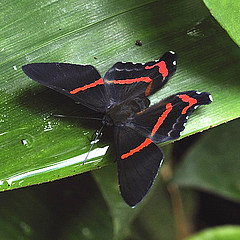Ancyluris aulestes (Cramer, 1777)
Common Name:
Aulestes Doctor
Aulestes Doctor
Synonyms:
Papilio aulestes (Cramer, 1777)
Natural History:
These butterflies exhibit iridescent color on the ventral side of the wings, and the males use to mark territory when it is resting. Species of this genus are associated with environments in good conservation state, but occur with low abundance (Constantino et al 2012). The same author showed 11 species that occur in Colombia.
Distribution:
Brasil; Colombia; Perú; Suriname
Brasil; Colombia; Perú; Suriname
Feeding Adult:
On nectar, minerals on river banks
Feeding Caterpillars:
For species Ancyluris are recorded species of plants of Melastomataceae and Euphorbiaceae (Beccaloni et al, 2008).
Color:
black, metallic, red
black, metallic, red
Habitat:
river bank, forest
river bank, forest
Publications:
- Beccaloni G.W, Viloria A.L., Hall S.K., Robinson G.S. (2008):
- Catalogue of the hostplants of the Neotropical butterflies. Book., London, S.E.A., Ribes, CYTED, Natural History Museum, IVIC: 1-536
- Constantino L.M., Salazar-E J.A., Rodriguez G. (2012):
- Estudio sobre el género Ancyluris Hübner 1819 en Colombia y descripción de nuevos taxa (Lepidóptera: Riodinidae). Boletin Científico Museo de Historia Natural. 16(2): 209-235




